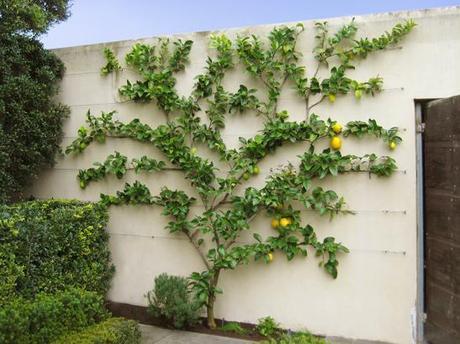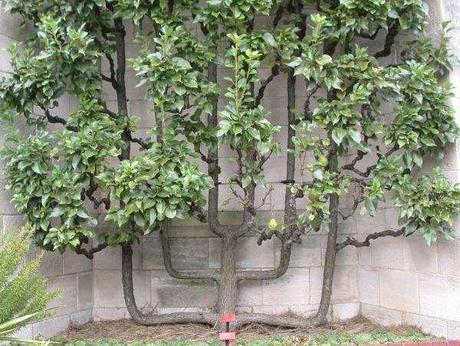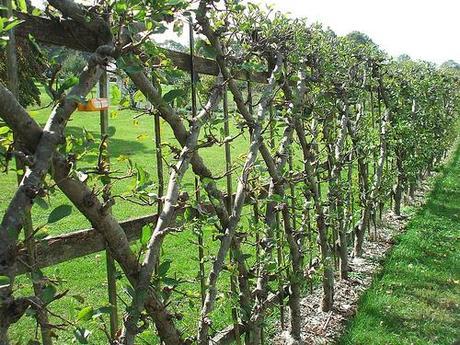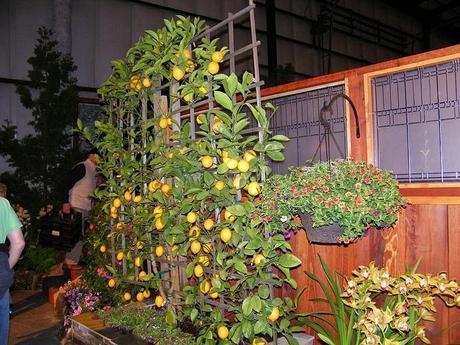Want an example?
Crepe Myrtles. Yes, they are pretty when flowering, kind of.
Why do I not like them?
In my yard, they are the last tree/plant to leaf out. The flowers make an absolute mess. The bark peels and exfoliates, which to some people is a plus.
They are the first tree/plant to lose their leaves in the fall. I am just not excited about them.
Want another example?
Espaliered trees.
Yes, I know, they do have some good uses to them. Even though I think they are about as ugly a thing as you can do to a plant or tree, they do actually make sense to some degree.
This is the topic for today. I had somebody ask me if I knew anything about them, is it possible to do it with a Citrus tree, and would I write something about it. The answer is YES to all three.
Historians note that fruit trees in the 16th century were trained in France to grow next to walls to take advantage of the extra warmth of the wall. If you have heard me speak or read any of my Citrus articles, you know this is right up that plants alley. Especially in borderline climates.
By the mid-18th century, espaliers were a major feature of European formal gardens, they can still be seen at Versailles and Fontainebleau. The colonists brought the method to America, where even today it can be seen at George Washington's estate in Mt. Vernon. There it was done with Apples and other fruit, not Citrus.
The formal definition of espaliered is: 1. a plant (as a fruit tree) trained to grow flat against a support (as a wall). 2. : a railing or trellis on which fruit trees or shrubs are trained to grow flat.
I am sure you have probably seen one, not necessarily Citrus, but just in case, here is what one looks like:
 Photo courtesy of Ian Barker Gardens
Photo courtesy of Ian Barker GardensThere are as many ways to espalier a tree as there are imaginations. There are several espalier designs, many with fancy names, including the single vertical cordon, the single horizontal cordon, oblique palmette with fixed limbs, Baldassari Palmette, the Belgian fence, lepage espalier with three branches, the U double, the verrier candelabra and the drapeau marchand. Don't let these fancy names scare you, they are all basically the same. You will need to determine your situation and what you want the tree to do.
There are some basic points and techniques that are common to all forms.
A word of caution here, patience is A MUST!! This whole process can take anywhere from 5-10 years to complete. Again, I am not wanting you to be scared of this, just don't expect to have it happen overnight.
Espaliers do best along sunny exposures, with loamy, well-drained soil. Find a spot near a brick or stone wall, wooden fence or trellis, allowing 6 inches of space between the tree and wall.
The tree must be in its first year or two of growth in order to be espaliered. Older trees are more difficult to train, as bending mature branches can take one to three years, and usually end up breaking when you try to form them in a different direction than they want to grow.
There will be work to do on the espalier all year, but a good bit of the training will be done in the spring, when growth is soft and subtle.
I stumbled across this picture from Homesteadrevival.blogspot.com. It is exactly the main gist of what you want to accomplish:
 Of course the more elaborate your fence, trellis or wall is, the more you will need to prune.
Of course the more elaborate your fence, trellis or wall is, the more you will need to prune.Speaking of pruning. As new branches come out at you, you have a choice, you can leave them and have a full frontal tree with a flat back, or you can keep them pruned back to give you more room and a neater appearance.
This article is mainly on Citrus, because that is my thing. I really can not think of a cultivar of Citrus that this would not work with. You can do this to pretty much any tree too, like other fruits, Magnolias, Camellias, etc. One major thing you have to keep in mind, if you are just trying to cover a wall or create some other kind of look, you may not want to use a deciduous tree, one that loses its leaves in the winter. You will be back to looking at the wall, with wires and bare branches running along it.
Like I mentioned earlier, this is not my cup of tea on how to train a tree, but I will list some of the benefits to this style of gardening.
- Espalier is efficient—it casts little or no shade on surrounding plants.
- Espalier is beautiful—it softens the appearance of walls and can be a focal point of garden designs and views while it displays the finer details of plants: stems, bark texture and color, leaf shapes, flower, and fruit.
- There is a year-round design effect.
- A quick, living fence can be established of espaliers as a privacy screen or as a backdrop for other plants.
As I was doing some research on this subject, I always try to make sure I am giving out the most accurate info, I came across some interesting espaliers that others have done. Maybe some of these will give you inspiration to try something just as interesting or in some cases, crazy.
 NOT for somebody with OCD
NOT for somebody with OCD
I think of a triton when I see this

WAY too much work involved here

I know you should never say never, so I will say this, if there ever comes a time that I HAVE to espalier trees, this will be the closest I come to it.
Happy Growing!
Darren
Espaliers do best along sunny exposures, with loamy, well-drained soil. Find a spot near a brick or stone wall, wooden fence or trellis, allowing 6 inches of space between the tree and wall.
Read more : http://www.ehow.com/how_7885929_espalier-lemon-tree.htmlEspaliers do best along sunny exposures, with loamy, well-drained soil. Find a spot near a brick or stone wall, wooden fence or trellis, allowing 6 inches of space between the tree and wall.
Read more : http://www.ehow.com/how_7885929_espalier-lemon-tree.htmlEspaliers do best along sunny exposures, with loamy, well-drained soil. Find a spot near a brick or stone wall, wooden fence or trellis, allowing 6 inches of space between the tree and wall.
Read more : http://www.ehow.com/how_7885929_espalier-lemon-tree.html

